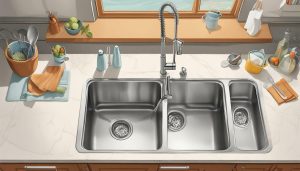A kitchen island is an essential element in modern kitchen design. It not only adds functionality but also acts as a centerpiece that ties together the overall aesthetic of the kitchen space. Designing a kitchen island can seem like a daunting task; however, with the right approach, it can be a fun and fulfilling experience.
In this section, we will explore the key steps to designing a functional and stylish kitchen island. We will cover various aspects such as design ideas, layout, plans, dimensions, styles, countertops, lighting, seating, and storage options for your kitchen island.
Key Takeaways:
- Designing a kitchen island requires careful consideration of various factors, such as available space and intended use.
- Before jumping into the design process, gather inspiration from various sources such as interior design magazines and websites.
- Planning the layout and functionality of your kitchen island is crucial to ensure it meets your needs.
- The dimensions of your kitchen island will impact both its functionality and aesthetics.
- Explore various styles of kitchen islands to find the one that complements your overall kitchen design.
- The choice of countertop material for your kitchen island will impact both its functionality and aesthetics.
- Proper lighting is essential for both practicality and ambiance in your kitchen.
- Incorporating seating at your kitchen island creates a welcoming space for family and guests.
- Maximizing storage space with clever solutions can help keep your kitchen organized and clutter-free.
Gathering Design Inspiration for Your Kitchen Island
Before embarking on your kitchen island design journey, it’s essential to gather inspiration to determine the direction you want to take. Browsing interior design magazines, websites, and social media platforms is an excellent starting point to get your creative juices flowing.
Look out for kitchen island design ideas that match your style, taste, and preferences. Take note of the different materials, shapes, colors, and finishes that pique your interest. You can save images, create a mood board, or jot down notes to help conceptualize what your island can look like.
Remember, your kitchen island should be functional and stylish, so take note of design elements that will serve both purposes. With a wealth of kitchen island design ideas out there, you’re sure to find something that inspires you and fits your style perfectly.
Examples of Kitchen Island Design Ideas
Here are a few kitchen island design ideas to get you started:
| Style | Description |
|---|---|
| Classic | A traditional kitchen island with ornate details such as decorative corbels, fluted pilasters, and raised panel doors. |
| Modern | A sleek, minimalist kitchen island with clean lines and a monochromatic color scheme. |
| Rustic | A kitchen island made with reclaimed wood or distressed finishes, incorporating elements such as open shelving and wrought iron hardware. |
| Colorful | A kitchen island that adds a pop of color to the space, incorporating playful hues such as teal, yellow, or red. |
| Multifunctional | A kitchen island that serves not only as an additional workspace but also as a dining area, incorporating features such as a built-in sink, wine rack, and seating area. |
Planning the Layout and Functionality of Your Kitchen Island
After gathering design inspiration for your kitchen island, the next step is to plan the layout and functionality of your island. As the central point of your kitchen, your island should serve a primary purpose, whether as a cooking station, a seating area, or a combination of both.
First, consider the available space in your kitchen and how your island will fit into it. Determine the location and orientation of your island, ensuring it allows for smooth traffic flow and doesn’t impede other work areas.
Create a rough layout plan of the island’s shape and size, keeping in mind the purpose it will serve. If it’s primarily for cooking, ensure your island has enough countertop space, a sink, and a cooktop or range. If it’s for seating, consider the number of seats needed and the appropriate height for the stools or chairs.
Additionally, decide on any additional features you want to include in your island’s design, such as a wine rack, open shelves, or a built-in cutting board. These elements can enhance the functionality of your island and make it a more versatile space for cooking and entertaining.
By carefully planning the layout and functionality of your kitchen island, you can create a space that not only looks great but also meets your specific needs and preferences.
Determining the Dimensions of Your Kitchen Island
One of the essential elements to consider when designing a kitchen island is its dimensions. The size of your island will largely depend on the available space in your kitchen, as well as your specific needs and preferences.
When determining the dimensions of your kitchen island, consider the following factors:
| Factor | Considerations |
|---|---|
| Countertop Height | Determine whether you want your island to match the height of your existing countertops or have a different height for specific purposes, like a lower area for food prep or a higher area for dining. |
| Countertop Depth | Consider the depth of your island’s countertop based on your intended uses, such as accommodating appliances or providing ample workspace. The standard depth for a kitchen island is 24-30 inches. |
| Countertop Width | Determine the width of your island based on how much space you have available in your kitchen and your intended uses for the island. The average width of a kitchen island is 3-4 feet, but this can vary depending on your specific needs and preferences. |
| Clearance Space | Make sure to leave enough clearance space around your island to allow for easy movement and access to other areas of your kitchen. A clearance space of at least 42 inches is recommended for a walkway. |
Taking these factors into account will help you determine the appropriate dimensions for your kitchen island that will maximize its functionality and complement the overall design of your kitchen.
Exploring Different Kitchen Island Styles
Your kitchen island style should match your personality and the rest of your kitchen design. Here are some popular styles you can consider:
| Style | Description |
|---|---|
| Traditional | These islands feature ornate details and decorative moldings. They often include a mix of wood finishes. |
| Transitional | Transitional kitchen islands blend traditional and modern elements. They have clean lines and neutral colors. |
| Modern | Modern kitchen islands have sleek lines and a minimalist design. They often include stainless steel or glass finishes. |
| Farmhouse | Farmhouse kitchen islands have rustic finishes and a cozy feel. They often include features like open shelving and distressed wood. |
There are also various shapes you can consider for your island, such as rectangular, square, round, or curved. Don’t forget to consider the material, color, and details, such as beadboard or molding, to ensure your island suits your design style.
Choosing the Right Countertop Material for Your Kitchen Island
The choice of countertop material for your kitchen island is crucial to both its functionality and overall aesthetic. It needs to withstand daily wear and tear, resist heat and stains, and complement your kitchen design. Here are some popular kitchen island countertop materials to consider:
| Countertop Material | Pros | Cons |
|---|---|---|
| Granite | Durable, heat and scratch-resistant, comes in a variety of colors and patterns | Expensive, requires sealing to prevent stains, heavy and difficult to install |
| Quartz | Durable, low maintenance, non-porous, wide range of colors and patterns | Expensive, can discolor over time with direct sunlight exposure, may crack under extreme heat |
| Marble | Timeless and elegant look, easy to clean, low heat conductivity | High maintenance, prone to scratches, chips, and stains, not heat-resistant |
| Butcher Block | Warm and natural look, ideal for food preparation, can be sanded and refinished | Requires regular oiling and upkeep, vulnerable to water damage, can harbor bacteria if not maintained properly |
| Stainless Steel | Durable, heat-resistant, easy to clean, sleek modern look | Prone to scratches and fingerprints, can be noisy, may show water spots |
Consider the pros and cons of each material and select the one that best suits your needs and style. Remember to factor in the cost, maintenance, and durability when making your final decision.
Illuminating Your Kitchen Island with Proper Lighting
Proper lighting is crucial for enhancing the functionality and ambiance of your kitchen island. The right lighting fixtures can provide sufficient task lighting for food preparation while also adding visual interest to your island.
Consider installing pendant lights above your kitchen island to create a stylish focal point that also provides ample illumination. Alternatively, recessed lighting can provide subtle yet sufficient task lighting while maintaining a clean and streamlined look.
| Lighting Type | Pros | Cons |
|---|---|---|
| Pendant Lights | Provides ample task lighting while also adding visual interest to your island. Comes in a variety of sizes, shapes, and styles to match your decor. | May require additional electrical work and installation, which can be costly. May not provide sufficient lighting for larger kitchen islands. |
| Recessed Lighting | Provides subtle yet sufficient task lighting while maintaining a clean and streamlined look. Can be spaced out evenly for a balanced look. | May not provide enough visual interest or design appeal. May require professional installation. |
For optimal illumination, consider a combination of both pendant lights and recessed lighting. This will provide sufficient task lighting while also adding a touch of style and visual interest to your kitchen island. Be sure to consult with a professional electrician to ensure proper installation and safety.
Adding Seating Options to Your Kitchen Island
Incorporating seating at your kitchen island is a great way to create a welcoming space for family and guests to gather while you cook or entertain. When selecting seating options for your kitchen island, consider the following:
- Comfort: Choose seating that is comfortable and supportive for extended periods of sitting.
- Style: Select seating that complements the overall design of your kitchen and island.
- Practicality: Consider the intended use of your island and seating, such as whether you’ll use it for eating, working, or socializing.
Some popular options for kitchen island seating include:
| Seating Option | Description |
|---|---|
| Counter-height stools | These stools are designed to fit under the island’s overhang and typically have a seat height of 24-26 inches. |
| Bar stools | Bar stools are taller than counter-height stools, with a seat height of 28-30 inches, and require a higher overhang on the island. |
| Built-in banquettes | A built-in banquette offers a comfortable and space-saving seating option, particularly for smaller kitchens. |
By carefully considering your seating options and needs, you can create a functional and stylish kitchen island that truly serves as the heart of your home.
Maximizing Storage Space with Clever Solutions
Having ample storage space on your kitchen island is crucial to keep your cooking space organized and tidy. Here are some clever storage solutions to consider:
| Storage Option | Description |
|---|---|
| Built-in Cabinets | Installed beneath the countertop, these cabinets provide ample storage space for larger items like pots, pans, and baking sheets. Opt for adjustable shelves to accommodate different-sized items. |
| Drawers | Drawers are a great option for storing smaller items like utensils, dish towels, and cutlery. Consider using dividers to separate different types of items and maximize space. |
| Open Shelves | Open shelves provide easy access to frequently used items like cookbooks, spices, and mixing bowls. Consider using decorative baskets or bins to keep items organized and visually appealing. |
Incorporating these storage options into your kitchen island design will help you make the most of your space and keep your kitchen organized.
Conclusion
Designing a kitchen island can be both exciting and overwhelming, but with proper planning and consideration, it can become the centerpiece of your kitchen. Start by gathering inspiration and determining the layout and functionality of your island. Ensure it fits appropriately with the available space and is suitable for your needs. Choose a style that complements your overall design, and select the right countertop material that suits both your cooking and aesthetic preferences.
Proper lighting and seating options can elevate the functionality and ambiance of your island, while clever storage solutions maximizes its potential. With these key steps in mind, designing a functional and stylish kitchen island that meets your needs is within reach.
FAQ
Q: What are some design ideas for a kitchen island?
A: Some design ideas for a kitchen island include incorporating different materials, shapes, colors, and finishes to match your style and preferences.
Q: How should I plan the layout and functionality of my kitchen island?
A: When planning the layout and functionality of your kitchen island, consider factors such as available space, traffic flow, and the primary purpose of the island. Create a rough layout plan to visualize how it will fit into your kitchen space.
Q: How do I determine the dimensions of my kitchen island?
A: To determine the dimensions of your kitchen island, measure the available space in your kitchen and consider factors such as countertop height, depth, and width, as well as clearance space around the island.
Q: What are some different kitchen island styles?
A: Different kitchen island styles include traditional, modern, and various styles in between. Choose a style that complements your overall kitchen design and personal taste.
Q: What countertop material should I choose for my kitchen island?
A: When choosing a countertop material for your kitchen island, consider factors such as durability, maintenance, and overall style. Options include granite, quartz, marble, butcher block, and stainless steel.
Q: How can I illuminate my kitchen island with proper lighting?
A: Install appropriate lighting fixtures above your kitchen island, such as pendant lights or recessed lighting, to ensure sufficient task lighting for food preparation and cooking.
Q: How can I add seating options to my kitchen island?
A: Incorporate seating options like counter-height stools, bar stools, or built-in banquettes at your kitchen island to create a welcoming space for family and guests.
Q: How can I maximize storage space with my kitchen island?
A: Maximize storage space with clever solutions such as built-in cabinets, drawers, and open shelves. Consider your specific storage needs, such as cookware, utensils, or pantry items.

It’s me, Amber Hayden, the heart and soul behind SagarmathaOnlineMedia.com. From a young age, I’ve been head over heels for everything home-related, from interior decor to gardening. I’m the type who can’t resist a well-crafted piece of furniture, and I firmly believe that a home isn’t complete without a pet or two. But it’s not just about creating pretty spaces for me. I’m all about making homes that tell a story reflecting the people living there. SagarmathaOnlineMedia.com is my way of sharing this passion with you. Whether you’re looking for tips to jazz up your living room, advice on pet care, or ideas to make your garden bloom, I’m here to help. So, let’s embark on this journey together and make your house a home!



